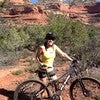Description
About This Video
Transcript
Read Full Transcript
Hi, I'm Kathy Corey and I'm going to be doing a program on one my favorite pieces of [inaudible] equipment, the petty pole. I'm joined by Kristy Cooper. Thank you for joining me, Christie. I worked quite a bit on the petty pole coming from um, a fitness and dance background and coming from a lot of misalignments in my own body. Uh, finding out how crooked I really was was quite an eye opener. And the petty poll is something that is going to really show us where our alignment is, but alignment is only part of what we do on the petty pole. You can get a fantastic workout as well as you will see. All right, so Christine, I'm just going to have you stand on the pole and we want to, um, have you stand just a little bit away from the pole.
And the first thing we'd like to do is look at your postural alignment and we're going to see how the pole work, uh, will actually help to create a, a deeper, stronger alignment from within the body and from within the workings of the structure of our alignment. So now I'm gonna have you just gently stand back and again, we see the alignment of the torso with the pole. I would like you to bring your heels lightly together, toe slightly apart, and just hold the straps in your hands. We are using a light to medium spring. Some of the petty pole work is done on a very heavy spring, but for this work in particular, because we are working with fuller range of motion, I like to work with a lighter spring.
I'm going to bring your arms directly out to the sign. I'm going to draw down from underneath the Scapula, really watching the alignment across the back and now bring your arms just up to shoulder level. The first is a great alignment exercise that we're going to bring the arms up to the sides and just lightly bring the hands together in the front and open it back. Now curl the hands lightly under and try and touch and open. That looks really nice.
Now close your eyes and let's see how aligned we are as we touch. Okay. Once again, once again. Okay, and open your eyes. So do we see we have a bully arm happening here. What we want to do is to correct it, not from the arm itself, but from underneath the shoulder blades. I would like you to take a breath. Inhale up, and as you exhale, draw down and I'll feel the alignment against the pole.
So as we're drawing down, we want to press evenly from the front of the ribs into the back of the ribs and open the arms lightly, lightly out. Beautiful. And now from here, press into the ribcage. Exhale and bring the arms together in the front. Very nice. And back again. One more time. Pressing in.
Draw it down into the pole, into the pole. And you're perfectly aligned. Now with that movement, did it feel different for you as you're working? It felt like the pole got more rounded. The Pole didn't actually change. What we're doing is changing our bodies to the pole.
But if you want that pole to be more rounded, it will be. So the idea again is to change our proprioception and our relationship. With all of the equipment as we're working. And now let's try that down to the size. Take an inhalation and as you exhale, just bring your arms in the lightly down to the sides and come back up and take the movement down and hold it there for that moment. Now what we want to look at is once again in this range of motion where we are, oh, so actually what we're seeing is exactly the same things.
Who as we came to the front, we were a little higher. As we go down, we are still a little bit higher. We're going to use our breath once again. So we're going to release the arm and we want to get a little bit more stretch in lengthens are going to take an inhalation and we're going to actually help bringing this arm down. Only let the other arm rest and relax and bring it back up. Float it down, floated down, and come back up one more time and inhale and draw underneath. Draw into the ribs, let the arm come down and let's see how we did.
So our second piece of tape matches our first piece of tape. So now we are even so we were a little bit higher. Now you're even. Alright. So now from this position, I'm going to just move that tape underneath your knuckles and we're going to relax your fingers in the next exercise. Good. And I'm going to go right to your fingertip and both sides and we're still good. Alright now as you come down, touch the tape every time.
So now the chape is giving us some information about the body. There it is. Let it float back up the rib state and we axial intake the movement down. Beautiful. And let's now put to the test, take it down, circle up and open out and press down. Remember we're using counterbalance so that even though the arms are coming to the front, the body has to stay very, very active to keep the pole in alignment.
So it's not wobbling front or back. One more time. Very nice. And do you see how they take, gives you that extra little um, idea of how to stay aligned through the shoulders without me having to say, try not to lift the shoulders up or don't work on evenly and the other way. Reverse the circle and press it down. Once again, we have to remember that we're pressing through the body, through the sternum and through the pelvic alignment to maintain neutral pelvis and to keep that pulse stabilized. Remember it is free standing and if in fact you don't work with balance and counterbalance, the pole will fall over. I have seen it happen. It's actually happened to me and and open and now we're just going to come down and to do a small circle and once again touch the tape, touch the tape and this time it's not enough to just touch the tape.
It's also touching the tape at the same time, circle around and touch at the same time. It's a lot of alignment and it's a lot of concentration, a lot of concentration. Touch it at the same time. And again, you are giving your body the information that it needs. Without me telling you what to do. Yeah, reverse it. So the tape is acting to create your alignment within yourself and after awhile you really begin to feel that the tape is there even when it's not and it creates a new body design, a new patterning in the body so that we work more in alignment. Great.
And just relax and release for a moment and we can take the tape off. Thanks. Yeah. Okay. The next exercise is a movement that I use all the time in my workshops. I use it as a beginning movement and a closing movement for whatever we're doing in our in the studio and that adds, we're going to just bring the arms in front. We're going to keep the alignment of our body.
Now the first thing we want to look at is how the spine is in relationship to the pole. We're going to begin our roll down so the head comes lightly off and we peel the body off one vertebra at a time, allowing the hands to go down. Now we must keep the tailbone pressed into the pole so that we are stabilizing the petty pole and this movement in that movement. Go down just a little more if you can. Beautiful, but remember the tailbone is still utilizing the resistance so that the pole is stable. From here it takes nice breaths. Remember to breathe. We're going to draw it in from the pelvis and the first thing I want you to do is move the tailbone down toward your heels from the tailbone a little more, little more, and stop.
This is creating a beautiful design. Now we're going vertebra to vertebra all the way up the pole and take a breath. Inhale, exhale, move the tailbone down. Move from the inside of the body, move that tailbone down and nothing here. Now we come through the center of the body, pressing the tailbone down, pressing through the center of the body, and hold for just a moment. Beautiful. From here, take another breath as you exhale, it's a nice rotation down.
Very nice. And now come from the naval in through the center of the body. Now it gets a little tough as if it worked half already. Now from here, take an inhale and exhale and go through the rib cage pressing and moving the bones so that we're really working vertebra, two Vertebra and great, keep dropping the tailbone toward the heels. Now from here we take this turn and go straight through the sternum to the back and hold. Very nice. Now to complete the movement, we don't want to think about lifting the head as much as we want to think about dropping through the scapula and bringing the shoulders all the way back. The head comes up and rests on the pole. Surprisingly hard, surprisingly difficult.
But and take the hands out and just step away for a moment and feel the difference in the spine. So when we're talking about doing our philosophies work, we're always talking about taking it with you. And this is one of the reasons, taking the tape with you. And we always talk about taking the movement with us, the alignment with us, and therefore do you feel a little bit longer and a little bit taller, lighter in the shoulders. And also this is really the creation of neutral pelvis. So at the beginning of the class and the end of the class, and I'd have people come in and just do that amount of work so that they really begin and leave with the body aligned with that spine being more flexible. As Mr [inaudible] said, you're only as young as your spine is flexible and this is one of the great things of working for me because of my scoliosis and what's one of the reasons they had me on it.
I would begin to roll and go to the side and come back to the other side. And that's how I found where my spine was. And everyone is really different with that now because it's so much fun. We had to do it again. And once again we align the body. We can take a lengthenings breath and we round the torso over bringing ribs in and role one vertebra time peeling off.
And we may remember that the tailbone in the safe room or our balance to counterbalance the movement, even though we're going forward, we still have to have full activation pulling back. So that we are resisting the movement all the way through. Now we're going to roll about halfway up. We're going to drop that tailbone, come from the inside of the body, inside of the body, move from the bones, and roll yourself up one vertebra at a time. Now from here, instead of rolling up, I want you to link in the spine outward. That's it. And then bring the arms around your ears. Beautiful. This time we keep the tailbone on where it is and we simply let the spring pull us up and place the body on the pole.
Let's do that one more time and begin to roll yourself down. One Vertebra. Beautiful. Keeping that the ribs in, keeping the length of the torso, keeping that tail bone intact with the pole, keeping the engagement through the upper body and we begin to roll by moving from the tailbone. Tailbone really stretches down toward the heels and we get about halfway up and now let the spine grow. Lengthen it all the way out, stretch it beautiful. And now just allow the body to float back up and into the center. We have one more of these and we add an arm movement to it, round the body over one vertebra at a time.
Roll your spine down, maintaining that length on the spine length on the tour. So beautiful. Look at how much deeper you are. You're also going as you're stretching over now that you're feeling quite secure with the petit Paul as well. Begin the rolling up, coming from that tailbone rolling down. Place the small of the back, let the spine grow and keeping everything in alignment. Ribs in. Use your breath and a small flutter of the arms. Just a tiny, tiny flutter.
You've got it. You have to be reaching back as you are reaching out. Everything is working in opposition and we are really working to maintain that length of the spine, the closing of the ribs and come back up and place. Yeah, it feels really great, doesn't it? It's really lovely. Now that same little flutter that we're going to do, we are going to take that to the side so the arms come down. We keep the main maintenance of the spine on the pole and let's go ahead and bring one arm over, bring the other arm over. Very nice.
Now the head turns. So you're right in the center of the arms in line, but the head stays back, the shoulder stays back and that small side flutter. So it's aside swimming exercise. Very nice. So the idea here is that maintenance of keeping that on a rotation with that small flutter and using the breath arm opens come around to the other side and you'll find one side a little more difficult than the other to maintain this alignment is because we have more rotation on one side than the other. So we want to work to even out the rotation in the balance through the movement and use the breath 19 lightly inhaling and exhaling and come back in to the center. Bring the arms lightly. Yeah. Next exercise we're going to do is chest expansion. We do it two ways.
The traditional way is to turn and face away from the pole. But I first teach it in this way because the idea is once again, the maintenance of the spine on the pole so that we're really getting the movement coming without leaning or hunching the body forward. So the movement itself is chest expansion. The arms come out and we take a long inhalation and come down. We turn the head to the side on an exhale to the other side on the exhale to the center on the exhale, and we lift the arms on the exhale.
So it's a really long exhalation, which means better be a really big inhalation to take it down. And once again, pull down and turn the hand. Exhale, exhale, exhale, exhale. Now the only thing that I'd like to see here is that the breath needs to be even all the way through. So in other words, we don't want to do inhale, exhale, exhale, exhale. We want it to be the same amount. So the breath should go [inaudible].
Exhale, exhale much better. One more time and take it down and inhale, exhale, exhale and a full ax. Hail to finish. Now that we have that, we're going to do it in the traditional way, which means you turn around, stand up and you faced the pole. Now you still want to think that your spine is aligned on the pole, which is why I like to do it the other way first because what we don't want to see here is the body moving forward because this spring that is for sure because the spring is pulling you and you want to pull into the pole so the arms extend out and once again it presses down. Yeah, anchor, anchor, anchor. It's a little more difficult and turn, exhale to exhale and exhale. Exhale. Do you see how much harder the breath is as well?
And again along full inhalation and exhale and exhale and exhale and well Leah eggs. Hell and again the spring should release at the same time. We've got just two more and take it to the side and exhale. Beautiful. Draw that tailbone down. Maintain that alignment through the body. Image the pole behind you so you cannot move forward or back. You've got, remember the Polish round that feel the roundness and last one and down it is hard and exhale, exhale, exhale and x and very nice you made it.
Let's go onto our place and we're going to start some work with our legs. So you're going to turn around once again and I have the heel slightly in front of the poem so that oral, shall I say, away from the pole so that you're not really pressing too much. We want to maintain neutral pelvis throughout this work as much as possible. We're going to just bring the arms out to the side and this spring is just a guidance for us at this point. So as you come down, what I really want like you to do is to think about grounding the heels so that the heels stay onto you, the uh, the Po, the petty pole base as long as they possibly can. Yeah. And then push back into the heel to rise back up. Lovely.
And once again, just that far push into your heel to come back up. Now this time go down and allow the heels to come up. But they'd come up only when they absolutely have to now press into the heel. The heel comes down to raise the body up and we use the pole all the way through, not allowing the body to tip the least little bit and we just are not pulling on this spring. Spring is guiding us, but we are doing all the work through the movement. And again, it comes with you, you absolutely and it's your guidance. It comes down beautiful.
Then we push through the heel and come up two more times and down and pushed through the heel to come up. Beautiful. Use the pole, use your balance and counterbalance and use the length of the tour, so all the way through the movement. Keep it long and come back up. Now we're going to do same movement, but we'll get you get to stay down this time and do a small arm circle image the tape on both sides of the thighs as you go down. And what we are looking for here is the evenness of the circles. Bring the arms down and around.
Good and use your breath. Inhale, exhale, inhalant axial. Reverse the circle five times and around and around. Good. Using the ribcage and all the way through your pelvic alignment. Push through your heels, slide up the pole and release this very, very nice. It's not easy, but it has great on exercise and great movement all the way through.
Now we're going to bring the legs to the parallel position and bend the arms. So now from here, go ahead and just and bend and just as much as you can comfortably beautiful and try not to tip the pelvis but to keep that neutral pelvis all the way through. Bringing from the pubic bone to the small of the back onto the pole, sternum into the center of the chest onto the pole. And from here we're just going to lift the heels. Don't move anything but the heels come yes and down. Beautiful and exhale as you lift and push through the yield and come down and up and come down. Two to go, heels beautiful and down.
Stay right over the center of the foot because you're stabilized through the pelvis. It helps to really bring the alignment toe, knee and hip. Okay, now just the arms with the knees bent and press the arms one and watched the risk position here because the spring shot sometimes tends to help have us break at the wrist. We want the risk to be absolutely secure and stabilized and exhale down. Inhale back elbow, stay in close to the body and reach and press. Let's put it together. Bend down, heels up, and one lift to lift, three to go, four and five and come back up and release. Good work. Let's go into some side bands or side stretching.
So the heels are together, toes just lightly apart and the arms come out to the sides of the body. From here we're going to bend over. Just allow the body to tip to the side so the shoulders will likely come off. But again our is through the pelvis and hips and come back up length and onto the pole and again lengthen up to go all the way over. Beautiful and lengthen and lift.
Notice how you might, how much activation you have to have through the alignment of the pelvis and through the abdomen in order to maintain the alignment as you stretch to the side. And again, beautiful and come up. And then this thing, we're going to go over to the side and we're going to bring this arm up, up and over. Beautiful. And now this arm presses down top, arm presses one and lifts press two. The gaze goes down to the floor, press three and up and take it across. There you go. And up and over, press down. One Beautiful, oh dear. One side. Once again, this is such a good thing for our alignment and to create our, no, this ain't, you've got the same spring. It's okay.
And it shows us our alignment. It shows us really where we need to work because you have to really activate from the interior of the body. Bring the arm up and across and now back to your first side and this time, side bend, first side sideband. And now this time up and over, now we make a full circle with the arm down around him. If nothing else moves down around and lift and use your breath and a full breath for the each circle. Come back up and others side take it. Oh over and circle down around him.
Lift and circle down around and lift and circle it better and lift and come back up. So it's really not that much about the arms as it is about the stabilization and working in a side bend with having to maintain the hip and pelvic alignment while we're doing work through the upper body. It was definitely, I've worked for everybody. It's a great exercise. That's really, and again shows us how much stabilization we need to work and do the polities work. So now let's work on do some, some footwork. So we're going to turn around and we're going to have you face the pole. Now we are going to oh ways when ever you grab onto the spring at least one foot needs to be on the base. I've had too many people do that. So we step both feet on the base and now we're going to take one foot and just step it to the back behind you. Good.
The back leg is going to Cape be straight and the arms are going to come lightly to the front. From here is just that back heel is gonna be come up and down and lift it up and down. Good and lifted up [inaudible] and down. Lift up and hold. Press the arms, one and good and two. Very nice. Keep that again. You have to keep the alignment and the stabilization even in both legs, even in both legs two more times and now last one and come up and change legs.
So we stepped both legs on and then one leg back. Very important to do and just the heels three times. Lift it. The back leg stays straight and comes down and straight and down and again, up and down. Lift it up and arms one, keep that yes and two beautiful three. Try not to lean forward, neutral pelvis, equal weight on both those legs for one more time.
Take it down and come up and step on to the base. Let's take that first leg back one more time. Now this time, what we want to do with this movement is we're really working on the alignment of the foot, so we keep the little bit of resistance in the spring, but we're going to roll the foot up, front, leg straightens and then roll it all the way over so you run the top of the foot so it rolls all the way to here. You really have to balance, really have to balance. There you go and roll it back and sit down and roll it up and over. Balance, balance, balance. That's it. You should be right in line with the pole. Absolutely.
The pole is your guidance here and up. Roll it all the way over, over, over. Nice and roll it back and down and change sides. It's really quite amazing. And in line with the pole, align the body, align the foot, equal weight now coming up and over without leaning forward or back up and over. Beautiful and up and back. No hopping.
He is a smooth roll. Working on the articulation of the foot that we get so much in our reform or work. And one more time. Up and over and back and come now step on and we'll do the same kind of lunch work, but we're going to be working in the arms and this is, I'm coming from uh, the step back. And once again we're going to keep the front leg bent back like straight heel down, arms front. This is the puncher and we first working with this single arm.
The idea here is to maintain your alignment across the shoulders and one arm is going to come back and then we change. Very nice and we change and use that springs. We have nice resistance all the way through the movement and press and change and push change. And again, now both arms come back and for shrunk as long as you have it stabilized. And now here's another point that is very, very important. If you're pushing the petty pole away from you and pulling the straps to you, the poll, the poll will slide, which we don't want.
So you have to be stabilized straight up and down so that you really work. Yes. So that you're working with the whole body, stabilizing the pole, not just the foot. And now a circle. We come back and we open the arms and circling front and yes, and around. Use your breath. Don't forget to breathe three and reverse it for three. Open it out and in and 4s and open it out.
I know it's the whole body. It's not our work at all because you've got to keep that nice and stable as you come in and around. Good change legs and repeat. So because it will be different on each side, it will particularly be different as you're feeling the alignment through the core work as well as through the arms. Single arm punchers first and we go back
One more set
Very nice. It's a good workout. Standing back onto the pole. This is one of my favorite exercises on here. It is a a series of exercises that work the whole body with art, with balance and movement and form. So we're going to begin
Lift up onto the heels, onto it. Lift the heels onto the toes. Sorry, and slide yourself down and lift the heels one more time and slide it down. Now let's do it first. With the feet flat, maintain the alignment with the pole. Bring Justice foot lightly to the front on your toe and let it float up without changing the spine.
There it is and down toe and then he'll roll the heel up. Other side. Let's see what happens here. Again, what are we looking for? Balance through the arms is one side pulling more than the other. Balanced through the pelvis and balance through the foot and down and change sides. Roll left. Very nice. We're rolling.
Come down there side. Watch that alignment through your yes, the hip so that the roundness of the pole is e then along the spine all the way through the movement. Very, very nice. Now the exercise,
Great. Where Christie and calm down. Lower the heels for that. You get a fun exercise. So I now to, again, we just going to have a little resistance on the arms with the, with the spring and we're going to roll through the foot and lift the leg up. Find your balance, extend your leg out, bend the leg in and bring it behind you onto the floor. Curling the toes under.
From here we are going to have you bend and straighten three times, so we slide down the pole and up and slide down the pole. Press back up and slide down the pole and come up. Now from here you bring the arms to the front. We're going to lift the back leg. Lean forward as you lift, but don't let go of your anchor point and then come back. Lean forward and let the lego higher beautiful and come back.
Lean forward each time we're going to go higher and deeper into the movement. Deeper into the movement. Beautiful. Come back now. Stay in this position. Let the leg lift lightly off the floor, anchor through the pelvis, circle the leg around and bring it all. This is the hardest part of the exercise, all the way to the front. Lean backs onto the pole, bend the leg and come down other side. Bend and extend. Bring the arms out and then behind you lowering. Lift three times.
Slide down the pole on one and come up on two and up. Very nice on three and come up. And now from that physician, let the leg lift, bring the arms front and we come front and come back higher onto beautiful and back. Higher on three all the way out, out, out. Stretch yet find your balance and come back and leading. Lightly forward. Lift the leg, circle it around.
And now press back into the pole. Bend and place one more each side. And let's do it a little bit. Uh, picking up the pace. Three, the movement. Show, arms out and up. Yes. Up and extend. Bend and place.
Slide. Lift to lift three and come up. Arms Front and one and two. Beautiful and three and up. Lift the leg. Circle that the arms open to the sides.
Bend and place again, other side. Up and extend. Bend and through slide on one lift to lift and three very nice and arms front. Lift the leg. And lift the leg and up deeper into it.
Lift the leg, beautiful. Come back up and like lightly off, lightly leaning. Circle from the hip into the hip into the front length in the torso. Bend the leg and place it all the way down. Very nice. Now we're going to do some facing to the side exercises at finish off our program. So from here you can still hold the handles.
It's the easiest way to figure out how to do this is to hold the handles first and then turn to the side. There you go. Now instead of the tailbone being your anchor point, it's your hip. You must anchor through the hip. Also, you must maintain the balance through the legs. If in fact you push forward, the petit pole could slide from underneath you. So you really need to have your balance in the center and your hip as your balance point.
Now from here where he was going to bring the arm over and we'd just do a small swimming
Use your breath and exhale all the way, all the way. Beautiful and come back up one more time and take it front and reach and come back up. Now it gets a little harder when you do it with that arm front. [inaudible] like that. So there's equal, the the hands will be unusual, but the spring will be because we're just pulling it around. So we're going to cal it the same amount of resistance on each arm. And here we go. It's a little harder. Reach it.
Rigid front is just as much as you can
Let's see how we do on this side. With the RM front anchor and begin stretch.
Inhale and began and use as many breaths you need, but fully briefed to go over and down using the breath into the movement. Much nicer view. Very good. So we're not rushing the movement, watching the hip alignment, keeping that tailbone, stretching toward the heels so the tailbone does not move back and behind us, but reaches all the way down toward the floor. And again, we start that journey up, starting to roll upward and roll one vertebra at a time. And now just up here, let go with this springs step off. And you are much taller than when we started. Alright, thank you very, very much Chris Day. And that's the great work on the petty pole. Thanks. Thank you. Thank you. Thank you.
Comments
You need to be a subscriber to post a comment.
Please Log In or Create an Account to start your free trial.





















